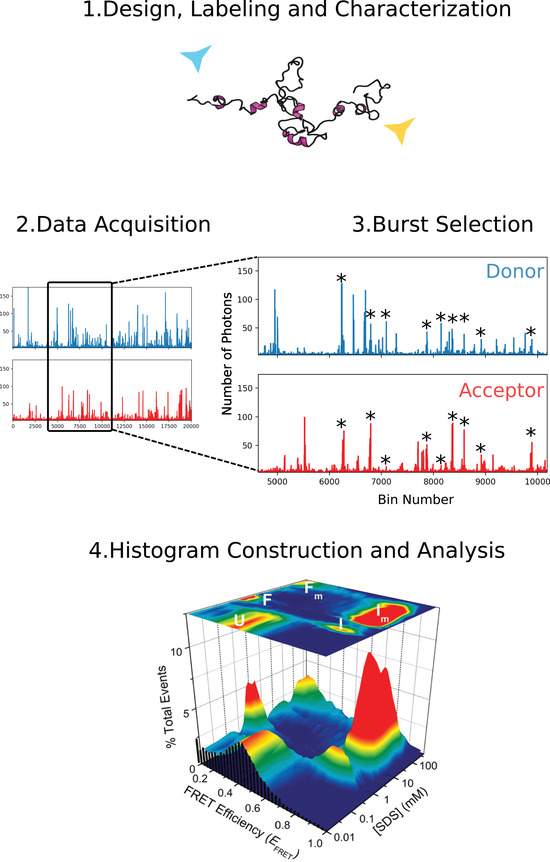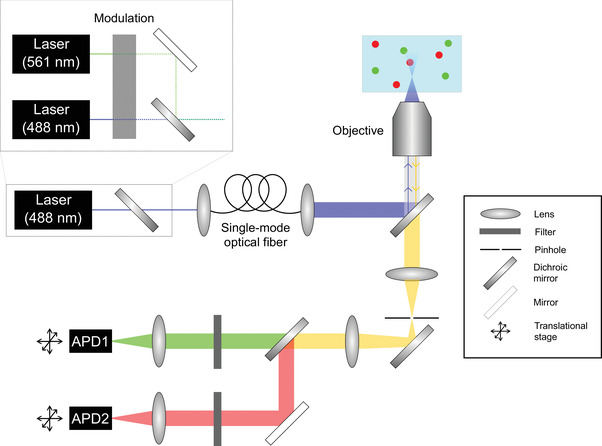{"title":"Ratiometric Single-Molecule FRET Measurements to Probe Conformational Subpopulations of Intrinsically Disordered Proteins.","authors":"Irem Nasir, Emily P Bentley, Ashok A Deniz","doi":"10.1002/cpch.80","DOIUrl":null,"url":null,"abstract":"<p><p>Over the past few decades, numerous examples have demonstrated that intrinsic disorder in proteins lies at the heart of many vital processes, including transcriptional regulation, stress response, cellular signaling, and most recently protein liquid-liquid phase separation. The so-called intrinsically disordered proteins (IDPs) involved in these processes have presented a challenge to the classic protein \"structure-function paradigm,\" as their functions do not necessarily involve well-defined structures. Understanding the mechanisms of IDP function is likewise challenging because traditional structure determination methods often fail with such proteins or provide little information about the diverse array of structures that can be related to different functions of a single IDP. Single-molecule fluorescence methods can overcome this ensemble-average masking, allowing the resolution of subpopulations and dynamics and thus providing invaluable insights into IDPs and their function. In this protocol, we describe a ratiometric single-molecule Förster resonance energy transfer (smFRET) routine that permits the investigation of IDP conformational subpopulations and dynamics. We note that this is a basic protocol, and we provide brief information and references for more complex analysis schemes available for in-depth characterization. This protocol covers optical setup preparation and protein handling and provides insights into experimental design and outcomes, together with background information about theory and a brief discussion of troubleshooting. © 2020 by John Wiley & Sons, Inc. Basic Protocol: Ratiometric smFRET detection and analysis of IDPs Support Protocol 1: Fluorophore labeling of a protein through maleimide chemistry Support Protocol 2: Sample chamber preparation Support Protocol 3: Determination of direct excitation of acceptor by donor excitation and leakage of donor emission to acceptor emission channel.</p>","PeriodicalId":38051,"journal":{"name":"Current protocols in chemical biology","volume":"12 1","pages":"e80"},"PeriodicalIF":0.0000,"publicationDate":"2020-03-01","publicationTypes":"Journal Article","fieldsOfStudy":null,"isOpenAccess":false,"openAccessPdf":"https://sci-hub-pdf.com/10.1002/cpch.80","citationCount":"5","resultStr":null,"platform":"Semanticscholar","paperid":null,"PeriodicalName":"Current protocols in chemical biology","FirstCategoryId":"1085","ListUrlMain":"https://doi.org/10.1002/cpch.80","RegionNum":0,"RegionCategory":null,"ArticlePicture":[],"TitleCN":null,"AbstractTextCN":null,"PMCID":null,"EPubDate":"","PubModel":"","JCR":"Q3","JCRName":"Biochemistry, Genetics and Molecular Biology","Score":null,"Total":0}
引用次数: 5
Abstract
Over the past few decades, numerous examples have demonstrated that intrinsic disorder in proteins lies at the heart of many vital processes, including transcriptional regulation, stress response, cellular signaling, and most recently protein liquid-liquid phase separation. The so-called intrinsically disordered proteins (IDPs) involved in these processes have presented a challenge to the classic protein "structure-function paradigm," as their functions do not necessarily involve well-defined structures. Understanding the mechanisms of IDP function is likewise challenging because traditional structure determination methods often fail with such proteins or provide little information about the diverse array of structures that can be related to different functions of a single IDP. Single-molecule fluorescence methods can overcome this ensemble-average masking, allowing the resolution of subpopulations and dynamics and thus providing invaluable insights into IDPs and their function. In this protocol, we describe a ratiometric single-molecule Förster resonance energy transfer (smFRET) routine that permits the investigation of IDP conformational subpopulations and dynamics. We note that this is a basic protocol, and we provide brief information and references for more complex analysis schemes available for in-depth characterization. This protocol covers optical setup preparation and protein handling and provides insights into experimental design and outcomes, together with background information about theory and a brief discussion of troubleshooting. © 2020 by John Wiley & Sons, Inc. Basic Protocol: Ratiometric smFRET detection and analysis of IDPs Support Protocol 1: Fluorophore labeling of a protein through maleimide chemistry Support Protocol 2: Sample chamber preparation Support Protocol 3: Determination of direct excitation of acceptor by donor excitation and leakage of donor emission to acceptor emission channel.


比率单分子FRET测量探针构象亚群的内在无序的蛋白质。
在过去的几十年里,大量的例子表明,蛋白质的内在紊乱是许多重要过程的核心,包括转录调节、应激反应、细胞信号传导,以及最近的蛋白质液-液相分离。参与这些过程的所谓内在无序蛋白(IDPs)对经典的蛋白质“结构-功能范式”提出了挑战,因为它们的功能不一定涉及定义良好的结构。了解IDP功能的机制同样具有挑战性,因为传统的结构确定方法通常无法确定此类蛋白质,或者无法提供与单个IDP不同功能相关的多种结构的信息。单分子荧光方法可以克服这种集合平均掩蔽,允许亚种群和动态的分辨率,从而提供宝贵的见解国内流离失所者和他们的功能。在本协议中,我们描述了一个比例单分子Förster共振能量转移(smFRET)程序,允许调查IDP构象亚群和动力学。我们注意到这是一个基本的协议,我们为更复杂的分析方案提供了简要的信息和参考,可用于深入表征。该协议涵盖光学装置制备和蛋白质处理,并提供对实验设计和结果的见解,以及有关理论的背景信息和故障排除的简要讨论。©2020 by John Wiley & Sons, Inc。基本方案:IDPs的比率smFRET检测和分析支持方案1:通过马来酰亚胺化学对蛋白质进行荧光团标记支持方案2:样品室制备支持方案3:通过供体激发和供体发射向受体发射通道泄漏来确定受体的直接激发。
本文章由计算机程序翻译,如有差异,请以英文原文为准。




